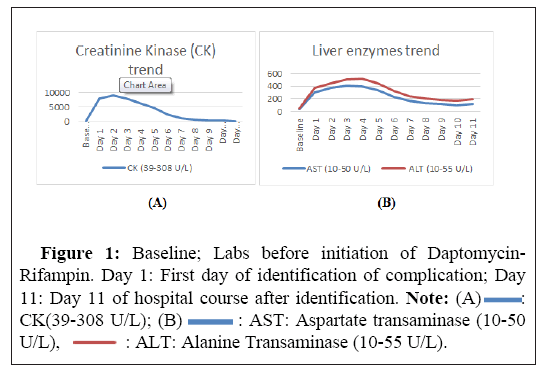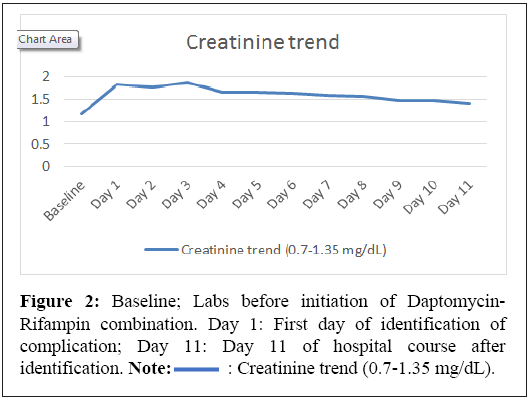A Search for the Risk Factors for Daptomycin-Rifampin-Induced Rhabdomyolysis, Liver Injury and Acute Kidney Injury
Received: 18-Apr-2023 / Manuscript No. JIDT-23-96354 / Editor assigned: 19-Apr-2023 / PreQC No. IDT-23-96354 (PQ) / Reviewed: 03-May-2023 / QC No. JIDT-23-96354 / Revised: 10-May-2023 / Manuscript No. JIDT-23-96354 (R) / Published Date: 17-May-2023 DOI: 10.4172/2332-0877.1000537
Abstract
The Infectious Diseases Society of America recommends daptomycin as one of the antibiotics for treating Methicillin-Resistant Staphylococcus aureus (MRSA) bone and joint infections and native valve infective endocarditis. The addition of rifampin may be particularly beneficial in cases of prosthetic joint infections due to rifampin's biofilm-disrupting properties, excellent bone penetration, and ability to prevent the emergence of resistance. However, safety data on the combination regimen is limited, and clinicians must be aware of potential adverse effects. We recently encountered a case of simultaneous rhabdomyolysis, acute renal failure, and hepatic injury associated with a Daptomycin-Rifampin regimen. In this report, we summarized the possible risk factors for these adverse events based on our extensive literature search and aim to contribute to the identification of at-riskpopulations for future studies.
Keywords: Liver injury; Acute kidney injury; Infectious diseases; Joint infections
Introduction
We recently reported a case of an 80-year-old male who developed a complication of rhabdomyolysis, liver injury, and acute kidney injury after starting daptomycin-rifampin combination for MRSA prosthetic knee arthritis, complicated by bacteremia and aortic valve endocarditis. The comorbidities included stage 3 chronic kidney disease, hypertension, and congestive heart failure; overweight (BMI of 28 kg/ m2) with hypoalbuminemia, and a fluid overload state. He received Daptomycin 1 mg/kg/day dose (based on actual body weight) and rifampin 300 mg twice daily [1-4]. About 11 days after starting the medication regimen, he presented with generalized weakness and confusion. His creatinine kinase (CK) level was 7940 U/ L (39-308 U/ L). At the same time, he was noted to have an acute liver injury and renal failure, a severe and infrequent combination of complications. He was treated with supportive treatment, including discontinuing the suspected offending agents, and his labs and clinical condition subsequently improved [5].
Case Presentation
A case of an 80-year-old male who developed a complication after using combination drug daptomycin which is previously known to cause an elevation in Creatinine Kinase (CK) levels, but levels to the proportion of rhabdomyolysis is a rare complication. Concomitant liver and kidney injury is even rarer; only four such cases have been reported in the literature search [1-4]. Ours was the fifth case [5]. All these cases occurred due to daptomycin alone and were not previously reported with the combination of daptomycin and rifampin. Ours is the first case of the combination regimen causing this complication in the published literature [5]. By reporting this case and reviewing the literature, we also tried to identify the risk factors, provide more evidence on potential risk factors, and identify vulnerable patient populations.
Results and Discussion
Risk factors
Obesity and overweight appear to be potential risk factors. Only limited literature about the role of obesity contributing to daptomycininduced rhabdomyolysis or elevation in Creatinine Kinase (CK) level is available [6]. The FDA-approved dosing for daptomycin uses actual body weight. The actual body weight used with the Cockcroft-Gault formula may overestimate the creatinine clearance, leading to a more frequent dosing schedule and exposing the patients to toxicity risks [7]. However, a previous study comparing efficacy on outcomes and safety data did not find a significant difference between patients dosed with actual body weight versus ideal body weight [8]. Our patient had edema and increased fluid weight from swelling from a history of heart failure. His Body Mass Index (BMI) was 28/Kg m2. It is possible that being overweight could also be a risk factor, especially when conditions like third spacing increase the body weight. Further extensive studies would be helpful. As seen in our patient, hypoalbuminemia could also be a risk factor [9].
A combination of rifampin could have contributed to liver injury in our patient, as studies reported a 1%-2% risk of hepatotoxicity with rifampin alone [10]. A smaller prospective study by Jugun, et al., to identify the risks and efficacy of the combination of rifampin and daptomycin showed the combination to be safe and effective for osteoarticular infection. None of the 16 patients in the study had evidence of rhabdomyolysis, liver injury, or kidney injury; only oneout of 16 patients required discontinuation of rifampin drug due to rash and ileus [11].
Underlying chronic kidney disease could be a risk factor for developing this severe complication since daptomycin is 52% renally cleared [9]. 4 out of 5 cases (including our case) that developed the complication of liver injury, renal failure, and rhabdomyolysis had chronic kidney disease. Interestingly, all five patients also had hypertension as comorbidity [5].
Statin was previously reported as a risk factor, and it is recommended to avoid statin in patients starting on Daptomycin [12]. In our patient, we followed this precaution, despite which the patient developed this complication. Risk factors are chronic kidney disease, Hypoalbuminemia, Fluid overload states or overweight, Obesity, Concomitant use of medications such as statins or rifampin (liver injury), Frequency and dosage of the medication, essential hypertension.
Monitoring and prognosis
More frequent monitoring of the labs (Creatinine Kinase (CK), liver enzymes, creatinine, and blood urea nitrogen) and daily monitoring of the symptoms in these patients may be ideal since the early diagnosis has a good prognosis with supportive treatment. Weakness, changes in functional status, and the muscle aches could be some of the identifying symptoms.
Despite the discontinuation of medication, some cases reported an uptrend of liver enzymes and Creatinine Kinase (CK) levels for a few days and a downtrend. This is likely related to the drug's time to clear off the system (Figures 1a and 1b and 2) [5].
We noticed that most patients recover completely from rhabdomyolysis, renal function, and liver injury with supportive treatment in 4-17 days, which is encouraging. Our patient recovered in 11 days.
Conclusion
Further data on the efficacy and safety of the Daptomycin-Rifampin combination with the help of more extensive studies are needed. Chronic kidney disease, hypoalbuminemia, hypertension, obesity, or increased body weight states such as overweight or anasarca, statin use could be potential risk factors for rhabdomyolysis, acute kidney injury, and liver injury. Most patients exhibit symptoms when Creatinine Kinase (CK) levels are significantly elevated to the proportion of rhabdomyolysis. Daily monitoring of signs, more frequent monitoring of labs in at-risk populations, and immediate checking of Creatinine Kinase (CK) level in case of symptoms of clinical myopathy may be ideal. The possible risk factors for these adverse events based on our extensive literature search and aim to contribute the identification of patient’s at-risk populations for future studies.
References
- Nishimura Y (2022) Daptomycin-related rhabdomyolysis complicated by severe hyperkalemia and acute kidney injury. Cureus 14: e29764.
[Crossref] [Google Scholar] [PubMed]
- King ST, Walker ED, Cannon CG, Finley RW (2014) Daptomycin-induced rhabdomyolysis and acute liver injury. Scand J Infect Dis 46: 537-540.
[Crossref] [Google Scholar] [PubMed]
- Kazory A, Dibadj K, Weiner ID (2006) Rhabdomyolysis and acute renal failure in a patient treated with daptomycin. J Antimicrob Chemother 57: 578-579.
[Crossref] [Google Scholar] [PubMed]
- Patel SJ, Samo TC, Suki WN (2007) Early-onset rhabdomyolysis related to daptomycin use. Int J Antimicrob Agents. 30: 472-474.
[Crossref] [Google Scholar] [PubMed]
- Ganipisetti VM, Dudiki N, Athavale A, Bollimunta P, Maringanti BS (2003) Daptomycin-rifampin-induced rhabdomyolysis, acute renal failure, and hepatic injury: a case report and literature review. Cureus 15: e36834.
[Crossref] [Google Scholar] [PubMed]
- Bookstaver PB, Bland CM, Qureshi ZP, Faulkner-Fennell CM, Sheldon MA, et al. (2013) Safety and effectiveness of daptomycin across a hospitalized obese population: results of a multicenter investigation in the southeastern United States. Pharmacotherapy 33: 1322-1330.
[Crossref] [Google Scholar] [PubMed]
- Bland CM, Bookstaver PB, Lu ZK, Dunn BL, Rumley KF (2014) Southeastern Research Group Endeavor (SERGE-45). musculoskeletal safety outcomes of patients receiving daptomycin with HMG-CoA reductase inhibitors. Antimicrob Agents Chemother 58: 5726-5731.
[Crossref] [Google Scholar] [PubMed]
- Ng JK, Schulz LT, Rose WE, Fox BC, Andes DR, et al. (2014) Daptomycin dosing based on ideal body weight versus actual body weight: comparison of clinical outcomes. Antimicrob Agents Chemother 58: 88-93.
[Crossref] [Google Scholar] [PubMed]
- Samura M, Hirose N, Kurata T, Takada K, Nagumo F, et al. (2021) Identification of risk factors for daptomycin-associated creatine phosphokinase elevation and development of a risk prediction model for incidence probability. Open Forum Infect Dis 8: ofab568.
[Crossref] [Google Scholar] [PubMed]
- Grosset J, Leventis S. (1983) Adverse effects of rifampin. Rev Infect Dis 3: S440-S450.
[Crossref] [Google Scholar] [PubMed]
- Jugun K, Vaudaux P, Garbino J, Pagani L, Hoffmeyer P, et al.(2013) The safety and efficacy of high-dose daptomycin combined with rifampicin for the treatment of Gram-positive osteoarticular infections. Int Orthop 37:1375-80.
[Crossref] [Google Scholar] [PubMed]
- 12. Dare RK, Tewell C, Harris B, Wright PW, Van Driest SL, et al. (2018) Effect of statin coadministration on the risk of daptomycin-associated myopathy. Clin Infect Dis 67:1356-1363.
[Crossref] [Google Scholar] [PubMed]
Citation: Ganipisetti VM, Athavale A (2023) A Search for the Risk Factors for Daptomycin-Rifampin-Induced Rhabdomyolysis, Liver Injury and Acute Kidney Injury. J Infect Dis Ther 11: 537. DOI: 10.4172/2332-0877.1000537
Copyright: © 2023 Ganipisetti VM, et al. This is an open-access article distributed under the terms of the Creative Commons Attribution License, which permits unrestricted use, distribution, and reproduction in any medium, provided the original author and source are credited.
Share This Article
Recommended Journals
Open Access Journals
Article Tools
Article Usage
- Total views: 912
- [From(publication date): 0-2023 - Nov 20, 2024]
- Breakdown by view type
- HTML page views: 813
- PDF downloads: 99






